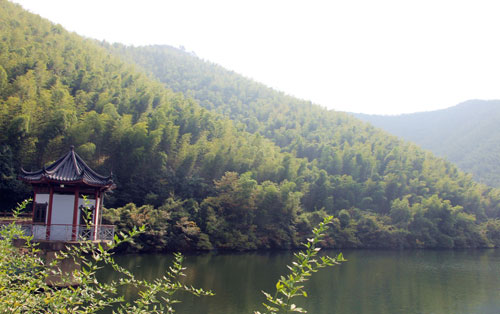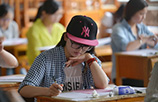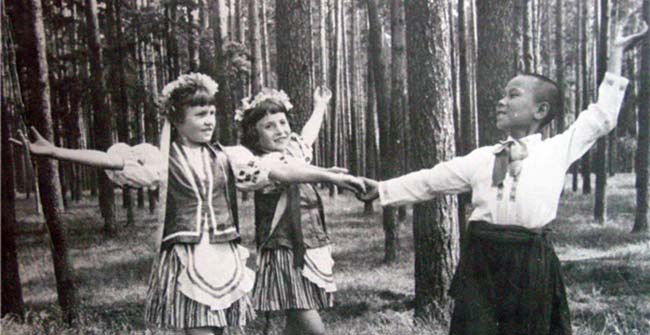Tucked away in a bamboo sea
(chinadaily.com.cn) Updated: 2015-10-21 10:56
 |
|
The gate of the Nanhai Bamboo Sea in Liyang, Changzhou city. [Photo/chinadaily.com.cn] |
 |
|
When the breeze blows, the bamboo leaves rustle and the lake shimmers in the sun. [Photo/chinadaily.com.cn] |
In an emerald forest that crosses the borders of three provinces, many local lives remain entwined with bamboo.
Nestled in the center of the Yangtze River Delta, where three provinces Jiangsu, Zhejiang and Anhui border with one another, is a bamboo forest called Nanshan Bamboo Sea, which is a national reserve. It occupies an area of 2,500 hectares.
The bamboo forest is largely unknown to tourists, as the region, a national economic center from 2,000 years ago, boasts too many places of historical interest developed a long time ago. The travel guides' omission of the bamboo forest makes it an ideal fairyland to escape to.
The reserve consists of several valleys and peaks, among which the 500-meter Wudi Peak is the highest in the delta region, covered with dense bamboo forest. The Wudi Peak is accessible through an 800-meter ropeway or a meandering mountain path. It takes about 12 minutes to reach the top of it by ropeway, and one-and-half hours on foot.
When the breeze blows, the bamboo leaves rustle, their trunks seem to sing because of the friction between joints, and the heads of the bamboo plants move together in rows of green waves flowing across the mountains and valleys.
After the rain, the bamboo forest is colored emerald green, and the people walking through it can even hear its happy singing. A bamboo plant can grow about 20 cm a day in ideal temperature, humidity and sunshine. When new joints grow out of the old ones, they make a special sound like kaka. When countless bamboos grow together, it sounds like a chorus.
Unlike forests that are made up of various kinds of trees and plants, the bamboo forest consists only of bamboos of the same moso variety, which are of the same size and color, because local people cut the bamboos every few years to support local bamboo industry. It takes many years to have a forest. But it takes only two to five years for a bamboo shoot to grow into a mature bamboo plant. If the typical forest has the charm of diversity, the bamboo forest demonstrates a beauty of uniformity.
In the reserve, there are a valley lake, several brooks and springs. The water adds vitality to the mountains. Tourists can rent bamboo rafts on the lake to view the bamboo forest from another perspective. It is like reviewing troops.
Because of the thick plantation, landform and altitude, the temperature in the bamboo forest is about five centigrade lower than that in the surrounding areas. The air is cool, humid and redolent with the faint scent of bamboo, making it a good place not only for sightseeing but also for physical exercises.
Several villages are located in the reserve, and the villagers are proud of the natural environment. There are several centenarians living in the villages. The local people attribute their longevity to the natural environment, a gift from heaven.
They abide by a set of rules that has been passed down the generations, observing the laws of the bamboos' growth. They maintain a good balance between the amount of bamboo to cut and to plant, and the balance between economic benefits and ecological protection.
In the middle of Wudi Peak is a 12.8-meter tall bronze statue of the head of a Longevity God, behind which is a screen wall inscribed with 68 Chinese characters of Shou, or longevity, in different handwriting genres.
Beside the statue are three stone monkeys - the first one covering its ears with its paws, the second one its eyes, and the last one, its mouth. The three monkeys stand for a philosophy of detachment popular among the local people, who believe that longevity comes more from meditation, than hearing, seeing and speaking. The hollow tube of a bamboo plant is also representative of the philosophy.
The local people's lives are inseparable from bamboo. Almost all their life necessities, building materials and agricultural tools are made from bamboo. Children learn early to plant bamboos and make them into useful things.
The most skillful bamboo weavers and carvers in these villages now perform for tourists in a bamboo museum in the center of the reserve. In their eyes, all parts of the bamboo are useful. They do not use any electrical machines, but only their hands and some simple iron tools. There is also a show of bamboo music, played on traditional Chinese musical instrument made from bamboo.
A must-see near the bamboo museum is a grand panda pavilion, where two young grand pandas, named Olympia and Zhuang Mei, are housed. The bamboo forest provides the couple with plenty fresh food.
Local restaurants offer tea and liquor made from bamboo, bamboo shoots, rice steamed in bamboo pipes and many kinds of food originating from bamboo that are beyond the visitor's expectations.
There is a bamboo delicacy that the villagers served a Ming Dynasty (1368-1644) emperor who had escaped from rebels to the inland Anhui province from Nanjing, once a capital of late Ming Dynasty. The old official road through which the emperor passed is still well preserved. Not far from the old road are 24 old pine trees planted in the Qing Dynasty (1644-1911) and several ancient stone tablets. The inscription on the tablets, though mostly unreadable because of the years of weathering, calls for the people to protect the bamboo forest.

- Seminar addresses humanitarian aid challenges
- New center to fight cross-border crime
- Program to boost medical benefits
- Taiwan's wartime resistance wins praise
- Stress, depression cool the Chinese passion for sex
- Financial reform to continue despite temporary market turbulence: Li
- Premier highlights reform, innovation to promote growth
- People in China, Japan feeling more positive toward each other
- Low birth-rate to drag down industry
- Hong Kong chief urges self-discipline







